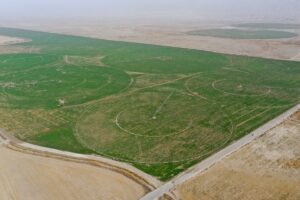 Pin
Pin The Mongols were a fierce people who lived in central Asia. Always on the move with their herds, they lived in circular huts made of a wicker framework covered with felt. There was never enough pastureland and the many tribes were continually fighting each other to obtain the best land. When the chief of one of the tribes returned from battle with a neighbouring tribe, he found that his wife had given birth to a son. He called the child Temuchin — after the chief of the defeated tribe.
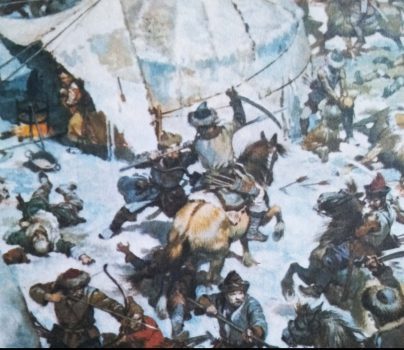 Pin
Pin 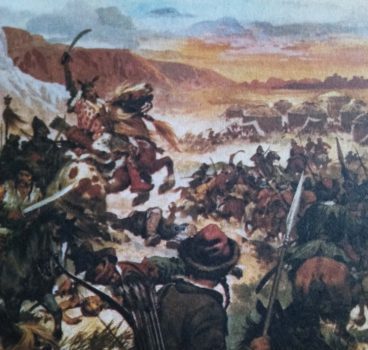 Pin
Pin When the boy was only 13, the old chief suddenly died. In those troubled times, nobody had much faith in such a young chief, and many left the tribe. But Temuchin’s talent for leadership soon became clear to everybody. He reunited his soldiers in compact armies, and launched them against neighbouring tribes. Over 20 years of relentless fighting, he defeated his enemies and united Mongolia under his rule. Temuchin had become the Khan (chief) of all the khans.
 Pin
Pin At his people’s request, he adopted the name Genghis Khan, meaning ‘perfect warrior chief’. He knew he must govern strictly with just laws and efficient administration, so he sent ambassadors to neighbouring countries to ask for advice.
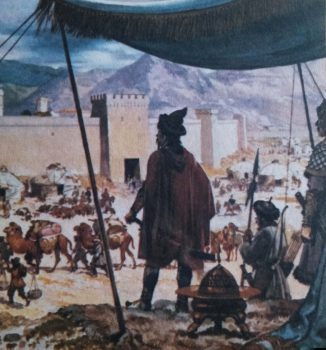 Pin
Pin As the capital of his empire, Genghis chose Karakorum in the heart of the desolate Mongolian plain. It became a majestic and powerful city, but Genghis chose to live in an enormous tent of white felt, lined with silk.
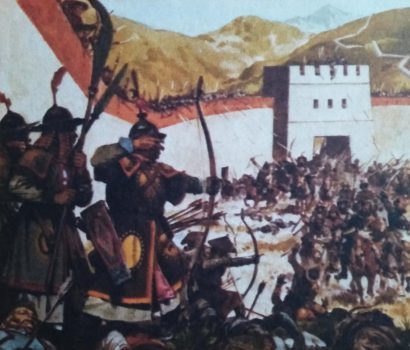 Pin
Pin His achievements so far should have been enough, but Genghis Khan yearned to spread his power. He had a proud and compact army, able to overcome any defence. He decided to attack China, seemingly protected by the Great Wall. A horde of 200,000 horsemen led by their invincible chief swept down on the ancient Chinese empire, breaking through the Great Wall at the pass of Wuliang-hai. The avalanche of horsemen now went ruthlessly on, capturing city after city.
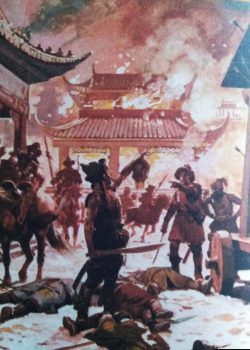 Pin
Pin 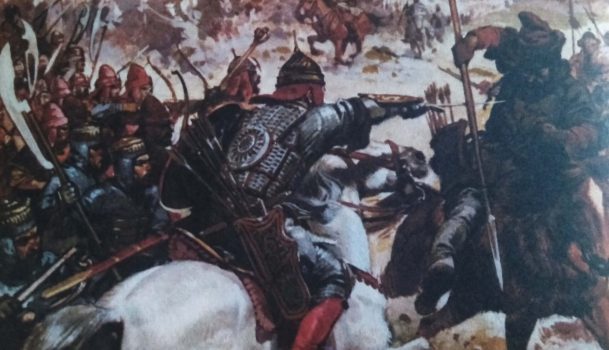 Pin
Pin Although just to his own people, Genghis Khan was a ruthless conqueror. Any city which resisted his armies was sacked and the inhabitants slaughtered. Even some which opened their gates to the advancing armies were similarly treated. The barbaric Mongols had no pity. Soon Genghis had control of all of North China, including the capital Peking.
But still he was not satisfied. Some Mongol ambassadors were murdered by the Shah of what is now eastern Iran and Afghanistan. Genghis led his armies westwards. He and his generals quickly occupied vast areas of Eastern Asia, Asia Minor and southern Russia. In the end, his empire became the most extensive that ever existed, greater than that of Napoleon, Alexander, or Britain in the nineteenth century. Genghis died in 1227 but his successors carried on his terrible tradition.
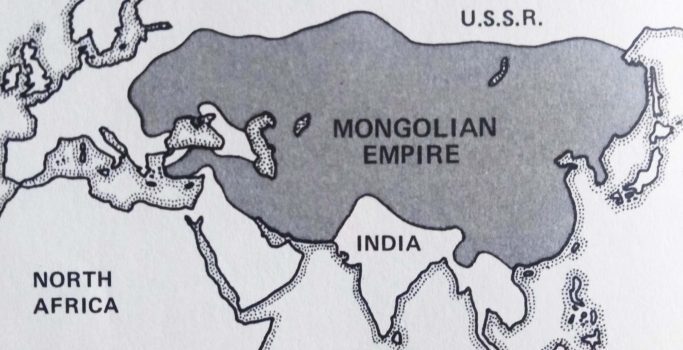 Pin
Pin No empire has ever equalled that of the nomadic Mongols. United for the first time during the 13th century by Genghis Khan, they burst of their barren heartland around Lake Baikal to conquer nearly half the world. After Genghis, the empire was divided amongst his sons.
The Mongolian Empire left a profound impact on world history
The Mongolian Empire, also known as the Mongol Empire, was one of the largest and most powerful empires in history. It spanned from the 13th to the 14th century and was founded by Genghis Khan in 1206.
Genghis Khan, whose birth name was Temujin, was a skilled military leader and strategist. He united the various Mongol tribes through a combination of diplomacy, military conquest, and a strict code of laws known as the Yassa. Under his leadership, the Mongolian Empire rapidly expanded its territories, taking over vast regions of Asia, Europe, and even parts of the Middle East.
The Mongolian Empire was known for its military might and highly organized military tactics. The Mongols were skilled horse riders and archers, and their cavalry was a formidable force on the battlefield. They were also known for their use of siege warfare, employing advanced techniques such as tunneling and catapults to take fortified cities.
Genghis Khan’s successors, particularly his sons and grandsons, continued to expand the empire, conquering large parts of China, Russia, and the Middle East. They adopted and adapted the cultural and administrative practices of the regions they conquered, creating a unique and diverse empire.
One of the key strengths of the Mongolian Empire was its administrative system. Genghis Khan implemented a highly efficient system of governance, dividing his empire into smaller administrative units known as “khanates.” Each khanate was ruled by a trusted subordinate, who was responsible for maintaining law and order, collecting taxes, and implementing policies. This decentralized system allowed the empire to effectively govern its vast territories and maintain control over diverse populations with different languages, religions, and cultures.
The Mongolian Empire was also known for its tolerance towards different religions and cultures. While Genghis Khan himself practiced shamanism, he allowed his subjects the freedom to follow their own religious beliefs. This policy of religious tolerance helped to foster stability and harmony within the empire, as different religious and cultural groups were able to coexist peacefully.
Trade and commerce flourished under the Mongolian Empire, as the Mongols facilitated the exchange of goods and ideas along the famous Silk Road. The empire had a vast network of trade routes connecting China, Europe, and the Middle East, allowing for the exchange of goods, technologies, and knowledge. This economic prosperity helped to fuel the expansion and wealth of the empire.
However, the Mongolian Empire began to decline after the death of Genghis Khan. Internal power struggles and divisions weakened the empire, and the subsequent rulers were not able to maintain the unity and cohesion that had characterized Genghis Khan’s reign. Additionally, the empire faced challenges from external forces, such as the resistance from conquered peoples and the arrival of the Black Death pandemic.
By the late 14th century, the Mongolian Empire had fragmented into several smaller khanates, each ruled by a different descendant of Genghis Khan. These khanates eventually disintegrated, and the Mongolian Empire was gradually absorbed by neighboring empires and kingdoms.
Despite its relatively short lifespan, the Mongolian Empire left a profound impact on world history. It created the largest land empire in history and facilitated the exchange of ideas, technologies, and cultures between different regions. The empire’s military tactics and administrative systems influenced subsequent empires and military strategies, and its legacy can still be seen in modern-day Mongolia and the diverse cultures of the regions it once ruled.
There were several key factors that contributed to the rise and expansion of the Mongolian Empire:
The rise and expansion of the Mongolian Empire can be attributed to their strong leadership, military tactics, adaptability, efficient communication system, political and administrative structures, diplomatic strategies, and economic policies.
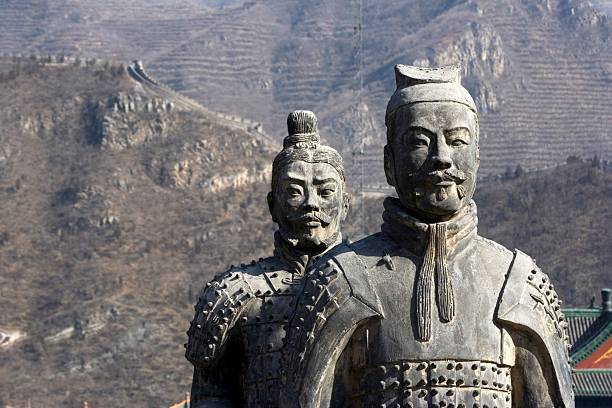 Pin
Pin The Mongolian Empire, led by Genghis Khan in the 13th century, had significant economic, cultural, and social impacts on the regions it conquered. Here are some of the major effects:
1. Economic Impacts:
- Trade and Commerce: The Mongols promoted trade and facilitated communication within their empire. They established a system of safe trade routes known as the Silk Road, which connected Europe, Asia, and the Middle East. This led to an influx of goods, technologies, and ideas across different regions.
- Taxation and Tribute: The Mongols imposed a uniform taxation system in their empire, usually based on the tributary system. This provided a stable source of income for the Mongols and helped fund their military campaigns.
- Agricultural Innovations: The Mongols facilitated the transfer of agricultural technologies, such as the cultivation of drought-resistant crops and the use of new irrigation techniques. They also promoted the domestication of animals like horses and camels, which aided transportation and trade.
2. Cultural Impacts:
- Spread of Mongol Culture: The Mongols promoted their nomadic culture across the empire, encouraging traditions such as horsemanship, archery, and wrestling. They also adopted various cultural practices and technologies from the conquered regions, infusing them with Mongol customs.
- Cultural Exchange: The Mongol Empire facilitated cultural exchange between different regions. Scholars, scientists, and artists could freely move across the empire, sharing ideas and knowledge. The Mongols promoted religious tolerance, allowing the flourishing of diverse faiths like Islam, Buddhism, and Christianity within their realm.
3. Social Impacts:
- Mongol Rule: The Mongols implemented a strict hierarchical social structure across their empire. Mongol nobles held top positions, while the local populations were organized into various administrative units. Mongol influence led to cultural assimilation among the ruling class and a blending of different ethnic groups.
- Diplomacy and Governance: The Mongols developed advanced diplomatic and administrative systems to manage their vast empire. They installed local rulers as puppets, granting them autonomy as long as they paid homage and followed Mongol directives. This approach allowed for relatively efficient governance over diverse regions.
- Population Changes: The Mongol Empire had a significant impact on population dynamics. The Mongols implemented policies to encourage population growth, often by relocating skilled workers and peasants to different parts of the empire. Conversely, large-scale massacres and forced migration during conquests led to population decline in certain areas.
The Mongol Empire had far-reaching economic, cultural, and social effects by promoting trade, facilitating cultural exchange, and reshaping social structures across the regions it conquered.
 Pin
Pin The Mongolian Empire, under the leadership of Genghis Khan and his successors, implemented various cultural, military, and administrative strategies that enabled them to effectively govern their vast conquered territories. These strategies can be summarized as follows:
Cultural Strategies:
- 1. Religious Tolerance: The Mongols were religiously tolerant, allowing their subjects to freely practice their own religions. This policy helped to promote stability and cooperation among diverse groups within the empire.
- 2. Adoption and Adaptation: Mongols readily adopted and adapted to the cultural practices and systems of the conquered regions. They incorporated talented individuals from different cultures into their administrative system, benefiting from their expertise and local knowledge.
- 3. Promotion of Trade and Communication: The Mongols actively encouraged trade and communication across their empire. They constructed a vast network of roads and trade routes, known as the Silk Road, which facilitated cultural exchange and economic development.
Military Strategies:
- 1. Superior Cavalry: The Mongols were renowned for their notable cavalry skills, mobility, and archery. They effectively utilized their cavalry units, known as the Mongol Horde, to conquer and control vast territories. Their mobility and efficient communication system facilitated rapid response to challenges and rebellions.
- 2. Psychological Warfare: The Mongols were masters of psychological warfare, primarily through their reputation for ruthlessness and destruction. This reputation often instilled fear and encouraged swift surrender among potential enemies, minimizing resistance in conquered territories.
- 3. Incorporation of Conquered Forces: Instead of annihilating conquered armies, the Mongols frequently incorporated soldiers from the defeated forces into their own ranks. By doing so, they strengthened their military power and reduced the likelihood of subsequent uprisings.
Administrative Strategies:
- 1. Yassa Legal Code: Genghis Khan introduced the Yassa, a comprehensive legal code that governed various aspects of life, including politics, trade, and social behavior. The Yassa helped in standardizing laws and order across the empire.
- 2. Decentralized Rule: The Mongols allowed local authorities to retain power and preserved existing administrative systems in conquered territories. This approach reduced resistance and allowed for relatively autonomous local governance, as long as tribute was paid and order was maintained.
- 3. Appointing Talented Administrators: The Mongols appointed capable administrators, regardless of their ethnicity or background, to govern conquered territories. These administrators were often given relative autonomy and were responsible for collecting taxes, maintaining order, and managing local affairs. This strategy helped to ensure effective governance and prevent rebellion.
The Mongols’ successful governance of their vast empire can be attributed to their cultural tolerance, adaptability, military prowess, incorporation of conquered forces, and effective administrative strategies.
Frequently Asked Questions : The Mongolian Empire
The Mongolian Empire was one of the largest and most powerful empires in history, formed by the Mongols under the leadership of Genghis Khan. It spanned from the 13th to the 14th century and covered a vast territory that included modern-day Mongolia as well as parts of China, Russia, Central Asia, and the Middle East.
The Mongolian Empire began its rise in 1206 when Genghis Khan united the various Mongol tribes under his leadership. Through skillful strategies, military prowess, and a highly organized administrative system, Genghis Khan and his successors gradually conquered neighboring territories and expanded the empire.
The Mongolian Empire had several key achievements, including the establishment of a vast and efficient communication and trade network known as the Silk Road. They also promoted cultural exchange and protected merchants along these routes. Additionally, the Mongols implemented an advanced administrative system that allowed them to govern a diverse empire with relative stability.
The Mongols developed a complex administrative system to govern their empire effectively. They divided the empire into different regions or Khanates, each ruled by a local leader or Khan who answered to the ruling Khan in the capital. They also maintained a system of taxation, maintained law and order, and employed skilled administrators to manage various aspects of governance.
Genghis Khan was the founder and first Great Khan of the Mongolian Empire. He played a crucial role in uniting the Mongol tribes and establishing the empire. Genghis Khan was also known for his military strategies and tactics, his ability to inspire loyalty among his soldiers, and his introduction of merit-based promotion within the army.
The Mongolian Empire had a significant impact on global history. It facilitated the exchange of ideas, goods, and technologies along the Silk Road, contributing to the spread of knowledge and cultural diffusion between the East and the West. The Mongols also promoted religious tolerance, allowing the free practice of various religions within their empire.
Several factors contributed to the decline of the Mongolian Empire. Internal conflicts and power struggles among the Mongol ruling elite weakened central authority. Additionally, the vastness of the empire and the difficulty of governing such a vast territory stretched Mongol resources thin. Finally, the empire faced external pressures, such as the resistance from the Chinese and the Hungarian-Turkish coalition, which further weakened the Mongolian grip over their territories.
The Mongolian Empire’s legacy is still felt today. It left behind a rich cultural heritage, influencing art, music, and literature in various parts of its former empire. It also had an impact on governance systems, military strategies, and diplomatic relations. Moreover, the Mongols’ ability to connect different regions through trade networks influenced the subsequent development of global trade routes.
Today, Mongolia is an independent country located in East Asia. While it no longer possesses the vast territories of the Mongolian Empire, it maintains a unique cultural identity and is known for its vast steppes, nomadic traditions, and strong horse-riding heritage. Mongolia’s economy is primarily based on mining, agriculture, and tourism.
As Genghis Khan had many children, it is believed that there are millions of people who can trace their ancestry back to him. Genetic studies have shown that a significant number of people in Central Asia, especially in Mongolia and parts of China, share a common genetic marker associated with Genghis Khan. However, it should be noted that these claims are based on statistical estimations rather than verified individual family trees.




















